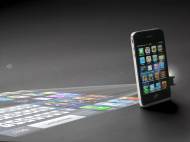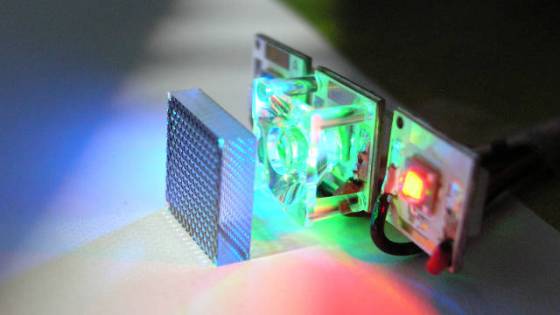Small LED projector projects sharp images on uneven surfaces
 In order to compensate for usually small display size on digital cameras and smartphones, many companies and research groups focused on development of small projectors that could be used alongside these devices to project larger images on nearby surfaces. Researchers from the Fraunhofer Institute for Applied Optics and Precision Engineering (Fraunhofer IOF) in Jena, developed a LED projector technology able to project sharp images on uneven surfaces.
In order to compensate for usually small display size on digital cameras and smartphones, many companies and research groups focused on development of small projectors that could be used alongside these devices to project larger images on nearby surfaces. Researchers from the Fraunhofer Institute for Applied Optics and Precision Engineering (Fraunhofer IOF) in Jena, developed a LED projector technology able to project sharp images on uneven surfaces.
While there have been other miniature projectors we described in our previous article, this technology is unique due to its capability to project images from an angle without distortion or affect on sharpness of projected image. Modeled after compound eyes in insects, the LED projector developed by Fraunhofer IOF researchers enables crisp and clear image projection of DIN A4 size, even if projected at a very flat angle with the beams illuminates the table surface at a diagonal.
“Our projector consists of hundreds of tiny microprojectors in an array, each of which generates a complete image”, said Marcel Sieler, a scientist at Fraunhofer IOF. “This technology, known as ‘array projection’ is modeled on nature – on the compound eye found in some insects – and with it for the first time we can create very thin and bright LED projection systems with tremendous imaging properties.”
In the simplest case of usage, when the image is projected vertically onto a level surface, hundreds of these tiny projectors cast the same image onto the viewing surface and create a sharp and bright picture. In a more complicated scenario where the device is positioned at sharp angle to the projecting surface, each little projector shines a slightly different image, which in superposition with other images from other small projectors results as a sharp overall picture. The resulting image is created from a function of the angle at which the image is projected, and of the geometry of the surface the image is projected on.
The large depth of focus of the micro lenses enables the use of these small projectors to project image on free-form screen geometries such as curved surfaces. The experts refer to this as the projector‘s “tailored focus” capability. While the position sensor and the smartphone‘s camera deliver the needed geometric information, the software this information to perform the needed calculations and compute the individual images along with their focus setting.
In order to use this projector, you just need to position the smartphone in a small cradle on a surface where you wish to project the image. If you want to zoom in on a portion of the picture, you can swipe the projection with gestures similar to those you use on your smarphone. Infrared lines used to detect surface during image overlay are also used to detect these gestures. For instance, if the user‘s finger breaks one of these lines with a swipe motion, the sensor registers this and advances to the next image.
Current prototype is suitable for use on static images, and the device measures just 2 x 2 cm (0.79 x 0.79 inches) in size. The optics were manufactured on wafers containing around 300 chips, each in turn housing 200 lenses for the microprojectors. Although the large amount of chips and lenses may seem as a deal breaker for commercial use, the Fraunhofer IOF researchers claim that their manufacturing process is suitable for mass production. They also claim that the technology should be commercially available in three or four years, since it does require a high pixel density on the part of the digital imaging system.










author
The researchers will premiere their prototype of the new LED projector at the Optatec trade fair being held May 22-25 in Frankfurt, Germany.